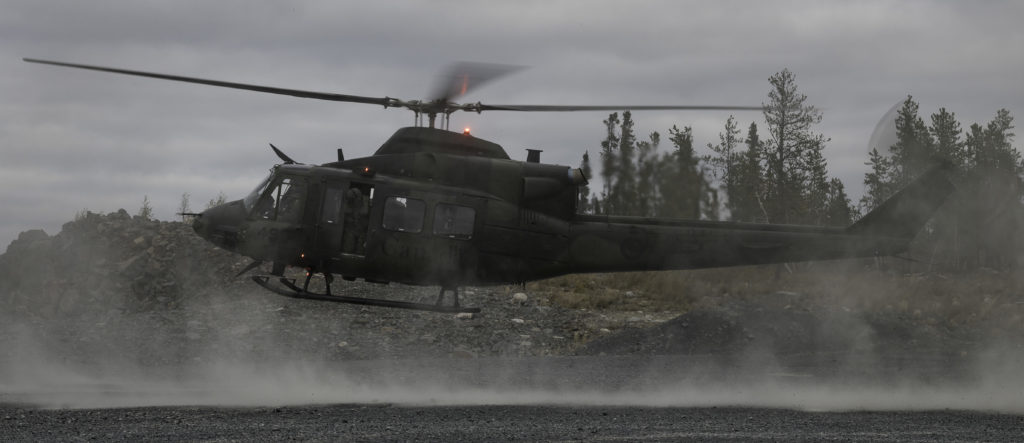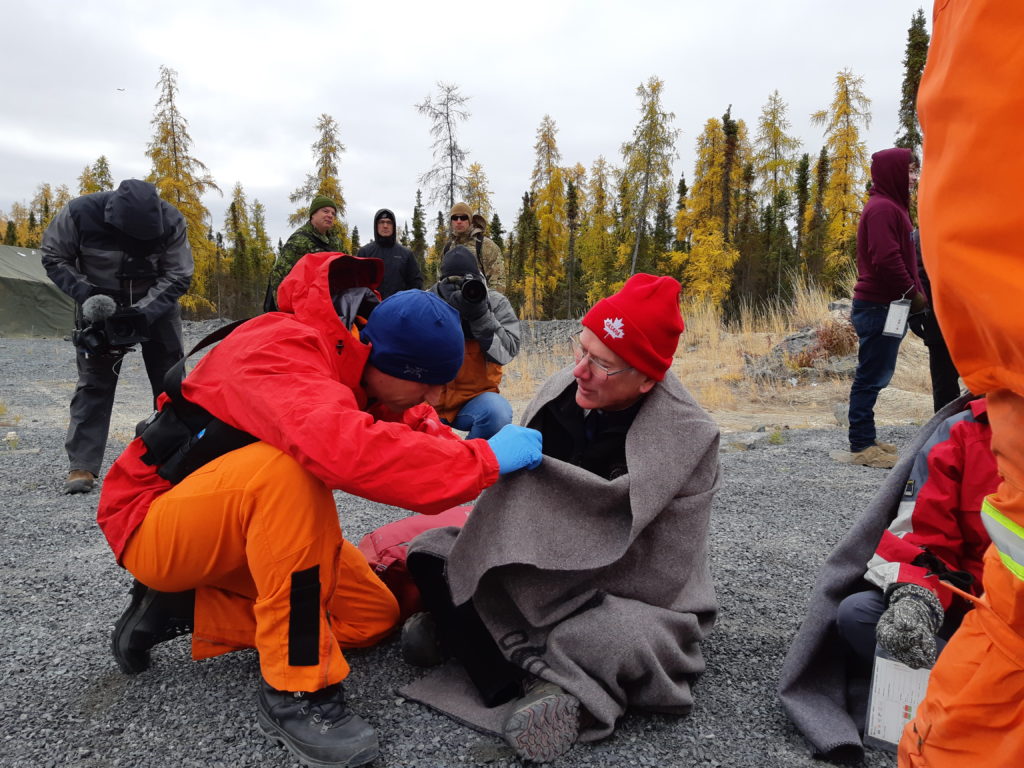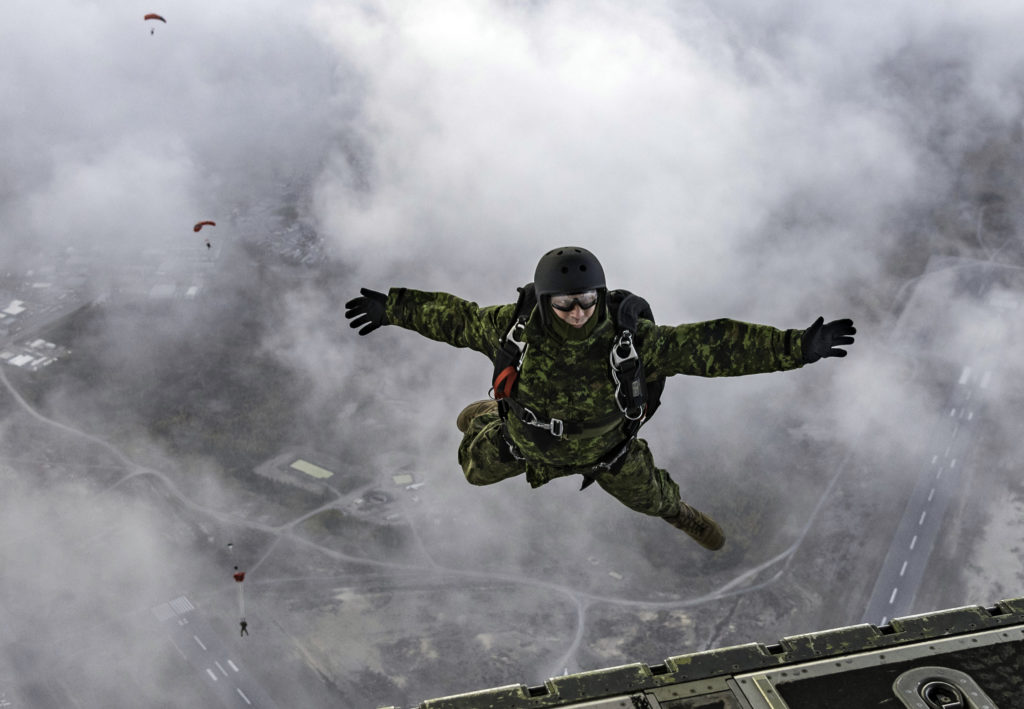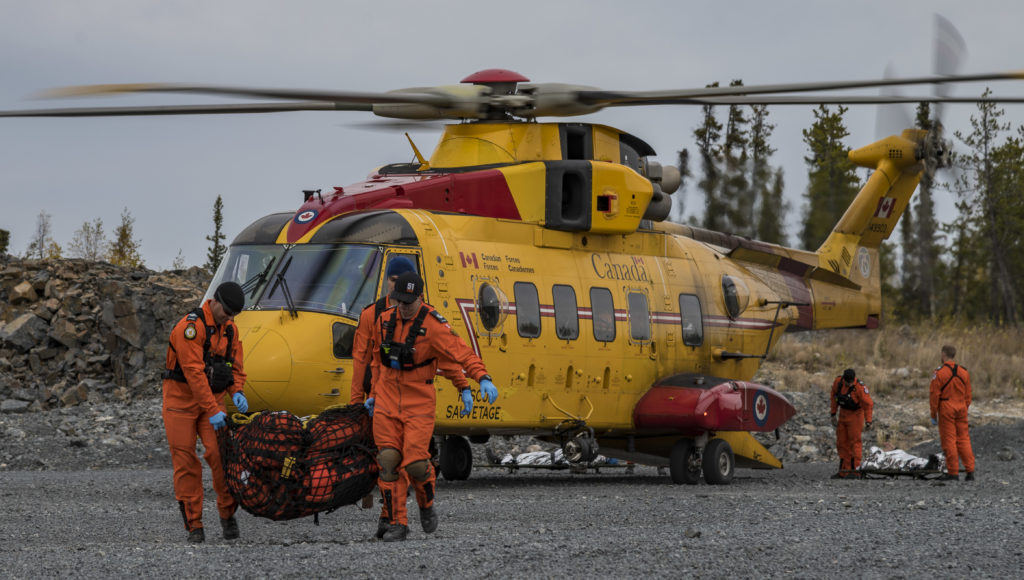Estimated reading time 14 minutes, 4 seconds.
“Our job is to turn chaos into order,” said MWO Daniel Pasieka.

Around him, members of the Canadian Army Advanced Warfare Centre scrambled to erect tents, heaters and generators; search and rescue (SAR) technicians swiftly triaged casualties scattered over the rocky crash site; and above, the last six SAR techs, buffeted by a swirling wind, jumped from a CC-130 Hercules into the frigid morning sky.
The mid-September scene was the simulated crash of an airliner carrying 190 passengers and crew near the northern tip of Banks Island, N.W.T. In reality, the controlled chaos was unfolding in a quarry on the Detah First Nation about 20 kilometres from Yellowknife. Successive waves of SAR techs from across the country had parachuted onto the incident site, along with the Army paratroopers and their major air disaster (MAJAID) container of supplies.
The timeframe had been condensed for the purpose of the exercises (Sachs Harbour, the nearest Hamlet on Banks Island, is an eight-hour flight from the nearest Joint Rescue Coordination Centre (JRCC) and SAR squadron at 8 Wing Trenton, Ont.), but the response was no less real. The technicians rapidly divided the site into sections and began systematically colour-coding and segregating the casualties displaying a range of injuries into red (the most serious), yellow, blue, green, grey (missing) and black (dead).

The paratroopers, carrying rifles to provide wildlife control, quickly broke down the MAJAID Sustenance Kit–two containers about 2.5 metres in length and 1.4 metres in height and weighing 1,750 pounds each, with food, tents, stoves, heaters and other supplies for around 320 casualties–to allow the technicians to begin treating those they could.
All the while, a Hercules circled overhead, providing communications between the team on the ground, the JRCC, an air task force commander, and a MAJAID health services team of 35 personnel setting up a forward base in Sachs Harbour (in fact, the Yellowknife airport, a short helicopter flight away).
For Pasieka, the on-scene commander and the senior team lead with 424 Transport and Rescue Squadron in Trenton, the subzero temperatures were recreating one of the greatest concerns in any northern rescue. “Right now, we are all casualties to exposure,” he observed, eyeing the warming tents as technicians repeatedly assessed exposed volunteer patients and themselves for signs of frostbite.
“The key is to get the victims out of the elements; then we can consider IV fluids and water (which would freeze) without the tents.”
As he looked over the activity, Pasieka was also starting to think about resupply. SAR techs jump with enough gear to sustain themselves for up to 72 hours. But even with food and water in the MAJAID kit, keeping a large number of casualties alive for more than a few days would be a challenge.
CH-146 Griffon and CH-149 Cormorant helicopters would soon be arriving on-scene to begin evacuating patients to health services at the forward base; but if this were the real deal, medevac might not occur for several days.

There is a need for “constant, constant resupply,” he said.
While many search and rescue exercises have a fuselage and other wreckage of an aircraft that SAR techs must navigate, the stark conditions of the quarry were just as arresting. Most techs were recent graduates of the SAR course, now assigned to operational squadrons, but brought back for “this specific iteration of training to get [them] their first exposure,” said MWO Darryl Cattell, the school warrant officer of Canadian Forces Search and Rescue School in Comox, B.C.
“This has to be practiced,” he said. “If this happened for real, they would have to uphold these casualties long enough so they could get them to a more definitive care facility. It’s not like most populated areas where you have an ambulance five minutes away from a hospital.”
VALIDATING THE PLAN
A major accident in a remote–or even inaccessible–part of the country is the nightmare scenario for the Canadian Armed Forces (CAF). The first team of six to 10 SAR techs would be airborne within 30 minutes of a call to the JRCC, and a second wave from SAR squadrons across the country and the Army paratroopers would soon follow. But those resources could quickly become overwhelmed if the military isn’t able to quickly integrate and work with municipal, provincial and territorial agencies and health and first responder services.

“We’ve been doing transpolar flights for over 50 years and there has always been the potential for an airliner to encounter trouble,” said BGen Dave Anderson, chief of staff of readiness for Canadian Joint Operations Command (CJOC). “As the North becomes more accessible, in essence we are exposing ourselves to greater risk. An Airbus has 320 people on it, a cruise ship could have 5,000 to 10,000, and once you take the people off the ship and put them on the land, you’ve got a land-based problem in a very unforgiving environment.”
CJOC has long had a contingency plan (CONPLAN) known as Soteria (the Greek goddess of safety, salvation and preservation from harm) to respond to a major air disaster, but this was a rare opportunity to test it in a live exercise.
“The intent of this exercise [was] to validate whether or not that plan would work,” continued Anderson. “This is the first time in a long time where we’ve validated it by doing a live exercise, where we’ve jumped in all of the requirements in order to respond.”

Anderson is no stranger to major disasters. He commanded the military response to the 2013 floods in Calgary, and served as chief of staff to the 2011 floods in Winnipeg. But he said the Arctic poses a unique set of challenges that can make any response difficult.
“The North is a very specific problem set, not just because of the physical geography but because of the human geography. If something goes wrong, it’s all hands to the pump,” he said. “When we arrive on scene, it’s quite possible there will be Canadian Rangers or fishermen or people from a local mining camp or the RCMP (Royal Canadian Mounted Police) already there.”
Noting the frequently cited saying among first responders that you can’t surge trust, he stressed the importance of developing an understanding and respect for those relationships before an incident occurs.
Exercise Ready Soteria was incorporated into Operation Nanook, an annual Arctic exercise since 2007 often focused on interoperability within the CAF and with government agencies and allies, to work on those relationships.
Though the exercise itself focused on the tactical problem of getting SAR techs into a remote location with many casualties and managing the command and control between the site and an air task force commander, earlier tabletop and command-post exercises worked though many of the interagency issues with representatives from provincial and territorial governments.
LCol Kevin Toone, the former SAR advisor at CJOC, told Skies in September 2017 that previous CONPLANs had limited detail about how agencies would actually link up in a crisis. Rather, there were “spaces where something magically happened” and coordination with civilian or other government departments naturally occurred.
His successor as of this summer, LCol Jay Steele, said the process of improving the CONPLAN “is an ongoing one.” Though lines of communication with outside agencies were simulated during Ready Soteria, he planned to hold a meeting at the end of the exercise on “consequent management and how do we as the military hand over the operation to regional authorities.
“We recognize the North is a big community and we’ve got to work together,” he said. “We don’t want to impose on some of the smaller communities because that takes away some of their resources.”
SUSTAINING THE RESPONSE
When an incident is deemed a major air disaster, the call to activate CONPLAN Soteria reverberates up the chain of command to the Chief of the Defence Staff. If it is approved and activated, an Air Task Force (ATF) commander is identified to assume command following the initial deployment of SAR resources.

The intent of an ATF, which can be up and running within 24 to 48 hours, is to establish a forward base from which to coordinate the response and allow the SAR squadrons to draw down aircraft that might be needed elsewhere in Canada. Ready Soteria provided an early glimpse into how that might work.
“It’s a big learning curve for a lot of people,” acknowledged Maj Rich MacEwan, the ATF commander in Sachs Harbour (in reality, Yellowknife).
“For this exercise, we’ve brought together a lot of elements of the CAF that don’t often work together,” he said, noting as an example the deployment of both search and rescue and tactical helicopter crews. “If we can get everybody collaborating on one mission that could happen at any time, that’s a big deal. It’s not something that we do often enough.”
While communications across a dispersed, multi-agency rescue effort was his primary concern, he too was thinking about the challenges of sustainment, especially when hundreds of passengers are involved.
“When the Air Task Force is deployed, one of the first things that we think about is, how are we going to sustain ourselves? We need fuel for airplanes, we need food and water for not only ourselves, but also for casualties. The kit we have is good for two, maybe three days, depending on how many people you’ve got,” he said. “CJOC is developing that sustainment plan for me but at the same time I’m reaching back to say I need these things.”
Anderson said the lessons on Ready Soteria and the various tabletop exercises would be absorbed into the contingency plan and shared widely with other agencies, governments, and first responders.
Among his early observations were the need for a more simplified command and control structure and greater resilience within the SAR community to respond to multiple disasters days apart, without requiring a lengthy time to reset MAJAID containers and other gear.
“Right now, the Air Task Force commander works for the MAJAID task force commander, who works for the commander of 1 Canadian Air Division in Winnipeg, who is also the air component commander for CJOC. It strikes me we should simplify the chain of command significantly,” he said. “We have existing structures and we’ll leverage those as opposed to having a bespoke command and control system that is different from what we normally do.”
Steele, a former CC-130 Hercules SAR pilot with experience conducting searches in the Arctic, agreed with Anderson on a more simplified reporting chain, but emphasized the importance of engaging the expertise of the Joint Regional Task Forces and local regional authorities.
“If there’s something I’ve learned, it’s connecting with that regional knowledge to allow us to really make that Air Task Force operate correctly,” he said. “We need to understand how the regional authorities and other government departments play a role, so that we understand how to reach into them and they understand what we are doing. I think that’s key.”









Tuktoyaktuk, Cambridge Bay, Hall Beach,Iqaluit, Resolute and Alert can and should be used as Supply points. Fuel can be brought in and stored in the underground tanks (if still usable) in Goose Bay and brought to other supply points by Herc. as required. Remember it gets very dark in the Arctic for many months and it would difficult to make night time para drops. It is very nice to make practice drops in daylight, try it at night.
This is basically a North American and NORAD problem and should be looked at in the same context as the North Warning System and financed accordinling. This not just a Canadian problem.
I am not talking thru my hat, I was there in 1956 when the Dew Line was being constructed and numerous times since then with the USAF and on behalf of the Federal Government.